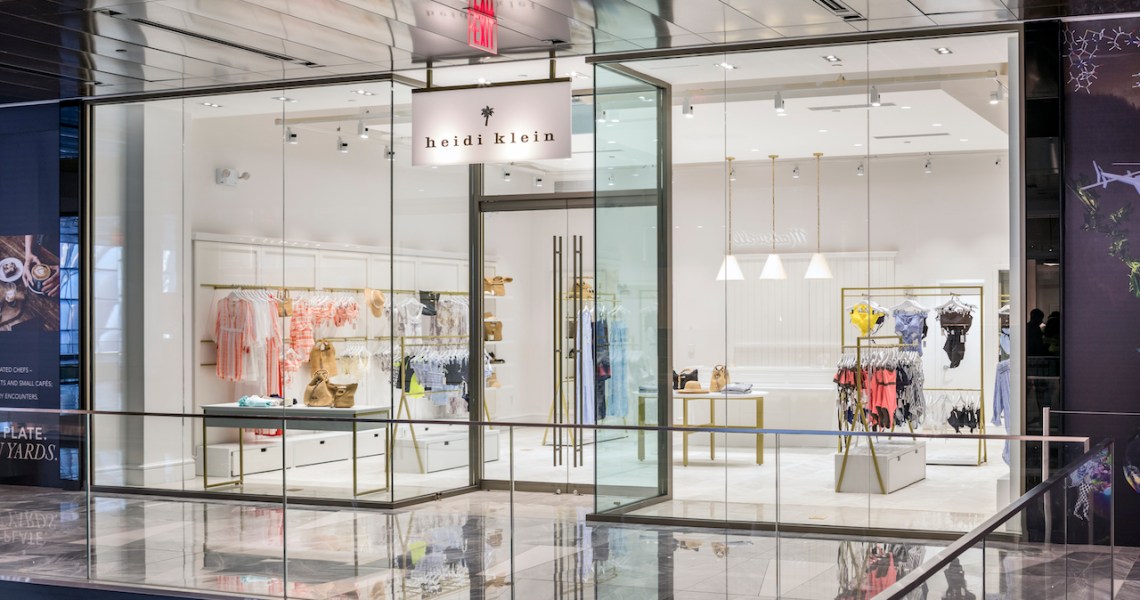For retailers that have set up shop on The Shops & Restaurants at Hudson Yards’ second floor, dubbed the Floor of Discovery, curb appeal may be the secret to success.
Dedicated in part to first stores of direct-to-consumer brands, the floor is a playground of sorts for anyone wanting to tap into fashion’s and beauty’s emerging concepts. But those opening stores understand few people can dedicate a day to bouncing around a mall. With many relying heavily on the foot traffic they’re being promised (65,000 visitors a day, according to developers, said Lindsay Meyer, Batch CEO and founder), they’re looking to win over the Floor’s curious shoppers with eye-catching window displays or welcoming entrances. Like their neighbors, they lack name recognition. So, many told me this week, luring shoppers means standing out from the DNVB crowd.
“We started with thinking what, visually, would make us seem more inviting and open,” said Nate Checketts, CEO and co-founder of Rhone. “I was inspired by markets in Europe — how you don’t really go through an entrance, but you seamlessly enter a store environment. Entering a store can be intimidating. So we have the most unique door structure of any brand. We had to push for approval, but it was worth it. It makes us stand out.”
Meyer, from Batch, said designing windows was new for her — the Hudson Yards store is Batch’s second location; the first, in San Francisco, is an old firehouse. She said she intends to take full advantage of the 40-foot-wide space. (The store is 1,800 square feet.) “We’re working on designing fun window installations to draw people’s attention. We’re hoping, just out of their own curiosity, they’ll wonder, ‘What’s Batch?’ and come in.”
M.Gemi’s strategy is drawing the eye by incorporating movement in the store’s window displays, though she didn’t want to give specifics on the design before the big reveal on Friday, Hudson Yards’ opening day. “Our window is our front door, and we’re taking full advantage of that. We’ll do something special on Monday to highlight our Monday drops — we have big plans,” she said. “Footwear’s part of the display, but it’s not just shoes on a shelf. Nobody’s doing that, and that’s one reason this [shopping] environment is going to be different.” — Jill Manoff
Nordstrom is using Pop-Ins to test beauty and wellness brands
Nordstrom’s Pop-in series, in which Olivia Kim curates a themed selection of products from a variety of lesser-known brands, is one of the many ways the retailer has solidified itself as one of the go-to partners for DTC brands today.
While some previous pop-ins have had a variety of products across the fashion and lifestyle category, the most recent curation, Fresh Faces, is focused entirely on beauty and wellness. I spoke to Olivia Kim, who gave me the rundown on why beauty was a better way to showcase diversity than a traditional fashion curation.
Ad position: web_incontent_pos1
“We curated around the theme of natural and inclusive beauty,” said Kim. “The shop features a mix of brands I personally love and brands that we wanted to introduce to our customer. Diversity and inclusion are key pillars in everything we do, and we wanted to bring together an assortment that anyone could shop regardless of their skin tone or gender. We brought in some well-loved natural beauty brands and mixed them with emerging brands that are lesser known.”
Kim said that focusing on beauty allowed her to bring in brands that explicitly cater to people of all skin tones and genders. For example, “nude” in beauty terms often means a white skin tone. Kim chose brands like Veque, which makes “nude” colors in a variety of shades, to upend that notion. She also said that genderless or gender-neutral brands like Necessaire were important additions to the shop.
For Kim, these pop-ins are not isolated affairs. They allow Nordstrom to test out new products, new categories and new brands in a limited way, before making a full commitment, while also allowing Nordstrom a constant stream of fresh new products for customers to explore.
“Pop-In@Nordstrom is a great place for us to test new concepts. We have nine locations across U.S. and Canada, as well as an online presence,” Kim said. “It’s so important to us that we continue to ignite a sense of discovery through providing newness. We have seen some of our successful Pop-In concepts materialize into longer-term partnerships at Nordstrom.” — Danny Parisi
The Marie Kondo effect in beauty
Since “Tidying Up With Marie Kondo” premiered on Netflix on January 1, its effects have been felt in the beauty industry.
Ad position: web_incontent_pos2
In January, Instagram account @EsteeLaundry began encouraging followers to participate in #ShopMyStash, which translated to “using less, buying less and using up what you already own by shopping your own beauty stash,” according to the account. This week, a new brand called Arrive launched, built on the concept of a curated approach by offering only the essentials of a makeup routine. It features just three products: a buildable foundation, compact bronzer and a brush.
“When we focus-grouped with consumers prior to starting Arrive, the No. 1 word that came up in association with shopping for beauty products was “overwhelming,” said Zoe Brenneke, founder and CEO of Arrive. “From day one, we wanted to rethink the development process by really putting thought behind what the consumer is using, as well as why, when and how, and then creating products that fit into their lifestyle, not the other way around.”
Of course, it’s not the first brand to opt for a curated concept. In May, clean hair brand Playa, which has just five products, was picked up by Sephora. In August, Perricone MD overhauled its assortment, deciding it offered too many products. (It discontinued 23 out of 180.) I have a hunch we’ll be seeing much more of this. — Emma Sandler




